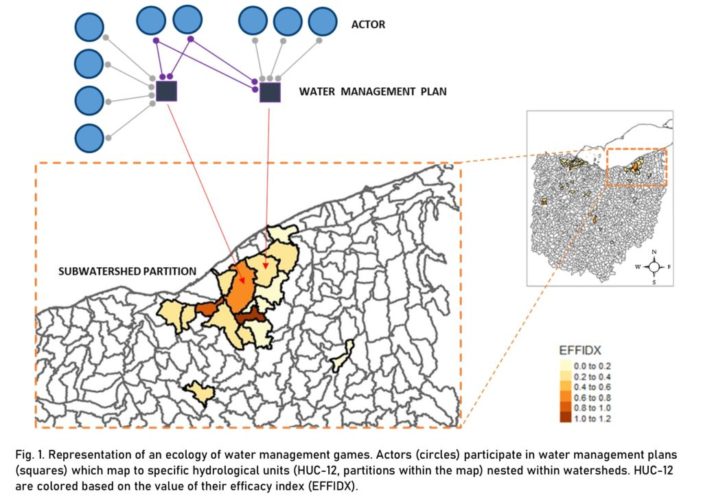Water Governance Past and ongoing research
My research on collaborative water management focuses on the interplay of several dimensions of complexity of the governance system, and the implications of social and ecological structures and processes on the institutional effectiveness of water management plans. Consider the following hypothetical case: imagine two venues that simultaneously tackle water pollution into a given watershed, with one located upstream from the second. If the venue upstream fails to restrict runoff into the river, it will affect the biophysical conditions of the sub-watershed downstream, effectively changing the problem the second forum seeks to address. This creates interdependencies: what happens in one part of the system affects the state of the system somewhere else.
This projects tackles some of the implications of this idea of interdependencies, and studies the case of non-point source (NPS) pollution as a complex governance system. Specifically, I think about this system as a social-ecological network. On this topic, my research addresses policy proposals related to different sources of water impairment, via a combined assessment of stakeholder involvement and management strategies targeting NPS sources in Ohio. I assess proposed policy actions included in water management plans (NPS-IS) and compare them with previous policy recommendations made by the Ohio EPA when developing Total Maximum Daily Load (TMDL) reports.

Source:
Holm, F., & Olivier, T. Polycentricity and Non-Point Source Pollution: An Examination of the Complex Governance of Water Quality Problems. Working paper.
To define the boundaries of the study system (in which issues, actors and policy institutions are interdependent) we make use of the pre-existent watershed partitions provided by the US Geological Survey. NPS-IS plans map directly to the smallest hydrologic units provided by the USGS (HUC-12). This allows to use sub-watershed boundaries to define the limits of the policy dynamics under consideration, since the jurisdiction of NPS-IS plans does not overlap. Theoretically, watershed boundaries are a useful demarcation, as they generally determine the limits within which collective action problems related to the resource can be resolved (Lubell et al., 2017).
This system can be thought of as a set of water management plans and actors that are connected via links of participation. Figure 1 provides a stylized representation of this process: blue circles represent actors participating in water management plans (squares). Each plan maps directly to a HUC-12 partition of the watershed, which are in turn nested within larger scales of aggregation. Gray links represent links of participation, and purple links highlight those actors that are participating in more than one plan. Actors participating in the development of multiple water management plans and the existent hydrological connections between HUC-12 are two critical forms of interdependence that will impact the performance of actors, and the efficacy and effectiveness of water management plans.
Key takeaways: participation in designing management plans matters, but more importantly, the nature of participation is critical for the overall outcome. Similarly, it suggests that more diverse processes not necessarily translate into positive feedback effects when trying to achieve policy solutions. Additionally, more effective plans (in terms of their policy recommendations) do not necessarily translate into enhanced environmental outcomes. For effective implementation to take place, other elements beyond the formal rules and objectives must also be present.
